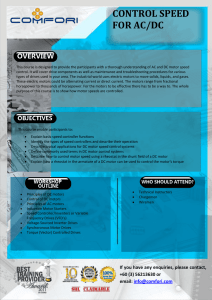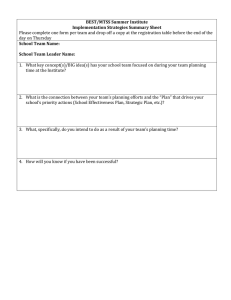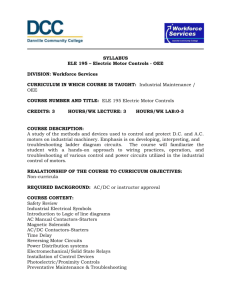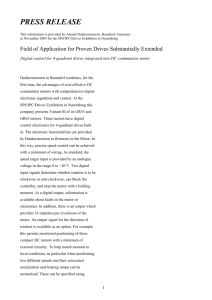COURSE SYLLABUS COURSE NUMBER: EEL 203
advertisement
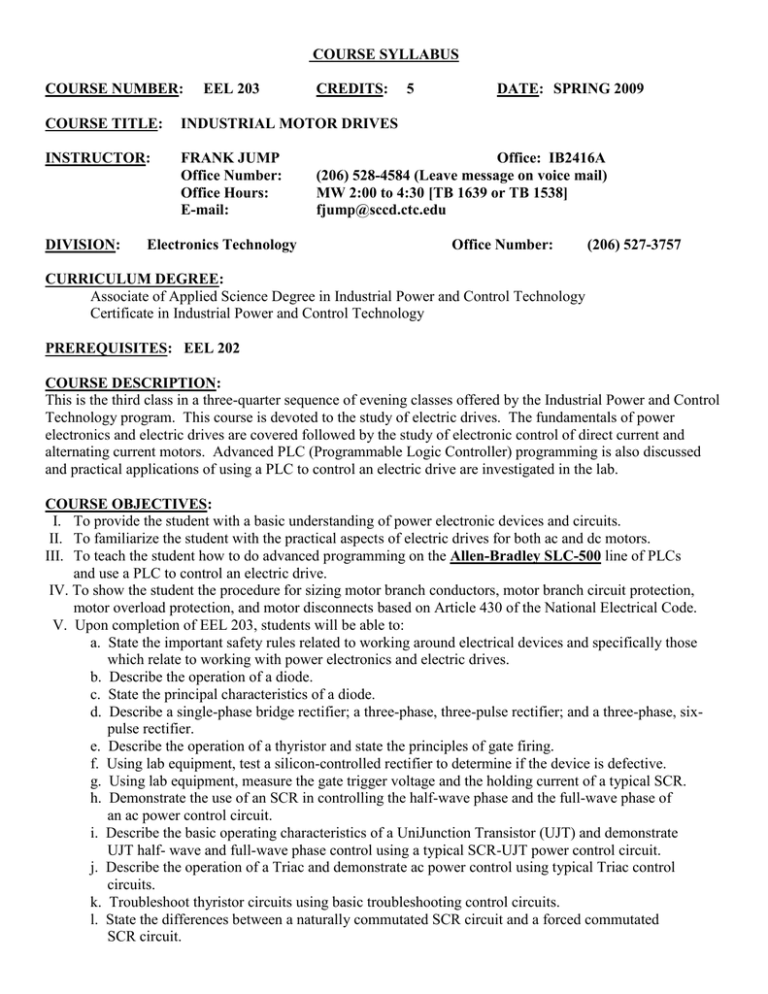
COURSE SYLLABUS COURSE NUMBER: EEL 203 CREDITS: COURSE TITLE: INDUSTRIAL MOTOR DRIVES INSTRUCTOR: FRANK JUMP Office Number: Office Hours: E-mail: DIVISION: Electronics Technology 5 DATE: SPRING 2009 Office: IB2416A (206) 528-4584 (Leave message on voice mail) MW 2:00 to 4:30 [TB 1639 or TB 1538] fjump@sccd.ctc.edu Office Number: (206) 527-3757 CURRICULUM DEGREE: Associate of Applied Science Degree in Industrial Power and Control Technology Certificate in Industrial Power and Control Technology PREREQUISITES: EEL 202 COURSE DESCRIPTION: This is the third class in a three-quarter sequence of evening classes offered by the Industrial Power and Control Technology program. This course is devoted to the study of electric drives. The fundamentals of power electronics and electric drives are covered followed by the study of electronic control of direct current and alternating current motors. Advanced PLC (Programmable Logic Controller) programming is also discussed and practical applications of using a PLC to control an electric drive are investigated in the lab. COURSE OBJECTIVES: I. To provide the student with a basic understanding of power electronic devices and circuits. II. To familiarize the student with the practical aspects of electric drives for both ac and dc motors. III. To teach the student how to do advanced programming on the Allen-Bradley SLC-500 line of PLCs and use a PLC to control an electric drive. IV. To show the student the procedure for sizing motor branch conductors, motor branch circuit protection, motor overload protection, and motor disconnects based on Article 430 of the National Electrical Code. V. Upon completion of EEL 203, students will be able to: a. State the important safety rules related to working around electrical devices and specifically those which relate to working with power electronics and electric drives. b. Describe the operation of a diode. c. State the principal characteristics of a diode. d. Describe a single-phase bridge rectifier; a three-phase, three-pulse rectifier; and a three-phase, sixpulse rectifier. e. Describe the operation of a thyristor and state the principles of gate firing. f. Using lab equipment, test a silicon-controlled rectifier to determine if the device is defective. g. Using lab equipment, measure the gate trigger voltage and the holding current of a typical SCR. h. Demonstrate the use of an SCR in controlling the half-wave phase and the full-wave phase of an ac power control circuit. i. Describe the basic operating characteristics of a UniJunction Transistor (UJT) and demonstrate UJT half- wave and full-wave phase control using a typical SCR-UJT power control circuit. j. Describe the operation of a Triac and demonstrate ac power control using typical Triac control circuits. k. Troubleshoot thyristor circuits using basic troubleshooting control circuits. l. State the differences between a naturally commutated SCR circuit and a forced commutated SCR circuit. m. Describe the operation of the following seven basic thyristor circuits: 1) Controlled rectifier supplying a passive load. 2) Controlled rectifier supplying an active load. 3) Naturally commutated inverter. 4) AC electronic contactor. 5) Cycloconverter. 6) Self-commutated inverter. 7) DC Chopper n. State the basic principle of operation of a three-phase, six-pulse converter. o. Describe one, two and four-quadrant speed control of a dc shunt motor. p. List several types of electronic ac drives and describe how they operate. q. Connect an Allen-Bradley SLC-500 to a dc or ac drive and program it to control the speed of a motor. COURSE CONTENT/MAJOR TOPICS: I. Review of standard motors including dc motors, ac induction motors and ac synchronous motors. II. Fundamental elements of power electronics. III. Power semiconductor devices including diodes, thyristors, bipolar transistors and mosfets. IV. Rectifier bridge configurations. V. Pulse Width Modulation Methods. VI. Fundamentals of electric drives. VII. Electronic control of direct current motors including dc thyristor drives and dc transistor drives. VIII. Electronic control of alternating current motors including ac inverter drives and flux vector drives. IX. Basics of applying drives. X. Energy saving opportunities using drives. XI. Closed loop control. XII. Servomechanisms and servodrives. XIII. Advanced programming of the Allen-Bradley SLC-500 including analog input and output. XIV. Code calculations of motor branch circuits. XV. Code calculations of motor branch circuit protection. XVI. Code calculations of motor overload protection. XVII. Code calculations for sizing motor disconnects. COURSE REQUIREMENTS: (Expectations of Students) Student attendance at 90% of classes and labs. Student must complete 90% of lab assignments. Student must maintain an average of 60% on exams. STUDENT EVALUATION METHOD: Two exams are given during the quarter. Attendance is taken. Ability to follow safety practices during lab sessions, ability to work with others on lab assignments, and ability shown in completing lab assignments will be factored into the final grade. TEXTS/MATERIALS/EQUIPMENT: Required Texts: Electric Motor Drive (Installation and Troubleshooting),Second Edition, by Glen A. Mazur & William J. Weindorf, American Technical Publishers, Inc. Electric Motors and Drives: Fundamentals, Types and Applications, Third Edition, by Austin Hughes, Newnes. Programmable Logic Controllers, Third Edition, by Frank D. Petruzella, McGraw Hill.
